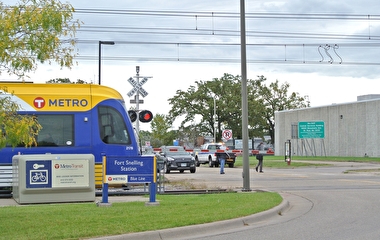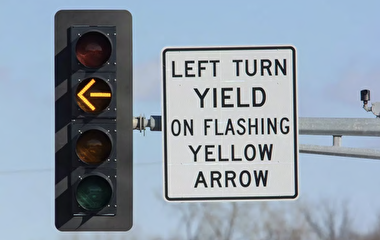Researchers at the U of M’s HumanFIRST Laboratory recently tested how in-vehicle signing—perhaps presented on a smartphone or vehicle display—could alert drivers and modify their behavior. Led by principal investigator Nichole Morris, the project examined how drivers react to in-vehicle sign (IVS) systems designed to prepare them for transitions to new driving conditions such as speed zone changes, school zones, construction zones, and curves.
The project, sponsored by the Minnesota Local Road Research Board, arose from a previous MnDOT study that looked at the feasibility of using smartphones for implementing connected vehicle programs. One of the questions that came out of that study was whether road signage could be eliminated from the roadside and displayed in the vehicle instead. Doing so could save tax dollars related to sign installation and maintenance, improve landscapes, and make it easier to keep signage up-to-date.
entering a school zone.
Researchers began by developing a simulated route for the HumanFIRST driving simulator using a real roadway network from southern Minnesota. Forty participants were asked to drive the 24-mile simulated route (which included freeways, two-lane rural roads, and towns) with and without the IVS system activated. As they drove, performance measures were collected.
The researchers found that an IVS system would affect driving performance in several ways. When it was used without external signs, speeding and speed variability increased. “Safety across all crash types was significantly reduced when in-vehicle warnings were used without external signs,” Morris says.
Speeds did not increase, however, when both IVS systems and external signs were used, and variability in speed declined slightly. “This suggests that as a supplement to external signs, the IVS system might reduce traffic speed variability and improve safety,” she says.
Victor Lund, a traffic engineer with St. Louis County and the technical liaison for the study, says traffic engineers are very concerned about the safety impacts of people driving at different speeds. “An IVS system might help reduce speed differentials, and we get really excited when we see something constructive toward that end.”
Another key finding from the study: IVS systems did not appear to cause driver distraction. “Sometimes smartphones are the cause of driver distraction,” Morris says. “An IVS system might be a tool to break that distraction by showing the driver there’s something important ahead and to change speed.”
The researchers also evaluated the usability of the technology. Test participants reported that the mental workload required to drive when an IVS was used instead of external signs was greater than under baseline conditions. Driver satisfaction with the IVS was also lower when it was used alone.
Based on the results, the researchers offer several recommendations. “Although using IVS systems instead of external signs would presumably save money on infrastructure costs, we do not recommend this,” Morris says. “However, we do believe that using these systems in conjunction with external signs has the potential to reduce speeding and crashes, and needs to be explored further.”
In the future, researchers hope to see this work expanded to examine the role of emerging IVS systems that could deliver important safety information between connected vehicles, such as speeds at intersections and work zones. In addition, understanding how drivers respond to IVS systems could assist emergency vehicles in creating a cleared path and encourage drivers to comply with “move over” laws, Morris says.




